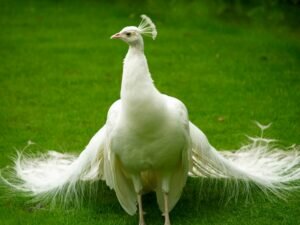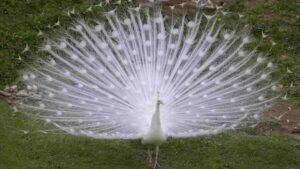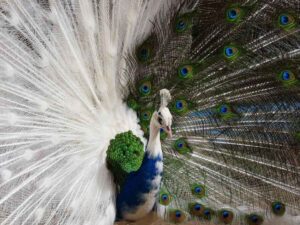White Peacocks- The term “peafowl” refers to three species of birds in the genera Pavo as well as Afropavo in the subtribe Pavonina of the family Phasianidae, the pheasants with their relatives. Although peafowl of any such sex are frequently known to popularly as “peacocks,” male peafowl are known as peacocks whereas female peafowl are known as peahens.
The white peacock is a subspecies of the blue peacock that is endemic to the Indian subcontinent but is now produced in captivity all over the world.
Why are white peacocks without any color?
While leucism can make animals fairly gentle in other species, this may not be the case with the white peacock. They’re equally as ferocious as their colorful counterparts, pecking and kicking anyone who tries to touch them. Even so, it’s tough not to be taken in by their beauty.
Where did White Peacock originate?
Peafowl evolved mostly around India and Ceylon, but after the British Empire invaded India, peafowl expanded throughout America and Europe. White peafowl appeared unexpectedly and are now cultivated for that color in confinement.
Theory and Hypothesis
The very first colour variation, as per the United Peafowl Association Knowledge Base, was the black shoulder, which occurred around 1830. It is uncertain when the white first emerged. Indian blues with white, pied, and black shoulder color patterns are uncommon in the wild. Any white markings would increase the bird’s visibility to attackers. According to the notion, their hereditary coloring genes evolved in the security of confinement. It has also occurred with pet birds like the zebra finch, as well as other animals such as the gerbil and Syrian hamster.
Personality as well as temperament
White peafowl, unlike gerbils, hamsters, or even zebra finches, are as unpredictable as their coloured peafowl counterparts. These are not often friendly birds, however great individuals who have been handled with care their entire lives may be more friendly or at the very least patient. They will attempt to flee from pens by pecking or kicking anyone who comes too close to them. Male peacocks of all colors make a very loud braying sound that may be heard for kilometers. Any hue of peafowl can fly.
Size
Males are substantially larger than females, measuring between 3 and 4 1/2 feet long and weighing between 9 and 13 pounds. Peahens typically measure 2 1/2 to 3 1/2 feet long and weigh 6 to 9 pounds.
Reproduction
Whenever white peacocks are paired with white peahens, each of their babies would be white. White peafowl do have the genes for black shoulder as well as pied color patterns. When paired with various colors birds, the chicks will have a wide range of colors. Peacocks mate in a brood of up to five peahens.
Expected Average Lifespan
In the wild, peafowl typically live between 10 and 20 years, however in cage, peafowl have indeed been recorded to survive approximately 50 years. Peahens typically produce a “clutch” of approximately six eggs, which females nurture for nearly two years before hatching. Only three days after hatching, chicks are capable of flying small distances.
What Is the Meaning of a White Peacock? What does it represent?
Peacocks are associated with a variety of religious symbols. Peacocks in general, instead of the white peacock specifically have a great deal of symbolic meaning.
The peacock is India’s national bird and signifies the Hindu cosmology’s sequence of time cycles. The peacock was produced in Hinduism from one of the feathers of the mythological bird Garuda, a massive majestic bird that carried Lord Vishu on its back. Peacocks play an important role in Hindu spiritual faith.
Melek Taus, known as the “peacock angel” by the Yazidi, is a key figure in their beliefs as a benign angel as well as an impersonation of God.
The peacock was a sign of eternity in ancient Greece because it was thought that the plumage of the peafowl would not degrade after death.
The eyes in the peacock feathers represent the all-seeing Christian God in Christianity.
Are White Peacocks Prosperous?
In some places, all peacocks are considered auspicious. In Hinduism, peacock feathers are thought to bring fortune.
In China, the peacock is seen as a favorable omen capable of warding off negative energy.
Do Albino Peacocks Exist?
There are albino peacocks, however they are far rarer than white peacocks. In reality, you are more likely to observe a white peacock than an albino peacock because, while the feathers are white, the eyes are not red, indicating that the animal has leucism rather than being a true albino.
Albino peacocks would be completely devoid of melanin, resulting in red eyes. Melanin is a set of natural colorants generated by most creatures which are accountable for the color of their skin, hair, or feathers.
How uncommon are white peacocks?
Although white peacocks are uncommon, they can be produced from other white peacocks and will spawn white peachicks if bred in captivity. As a result, white peacocks can be easily bred to create white offspring.
They would not be prevalent in the wild because the genetic mutation is extremely rare, therefore white peacocks would breed with natural blue peacocks, which would not normally create white offspring.
What Is the Price of a Peacock?
An adult peacock can cost anything from $35 to $275 on average. Birds with straight toes and no faults will be more expensive, but birds with a problem, such as a terrible colour patch or bad toes, can be in the $35 to $55 range.
Peachicks, or chicks, range in price from $10 to $30.
Hatching eggs can range in price from $45 to $85. Most breeders will want a minimum of four eggs to be purchased at one time.
We conducted some research on various varieties and have provided price averages below.
Average Cost of a Peacock
$50-$100 for a black shoulder
$200-$250 for a Cameo
$50-$75 for India Blue
$175-$250 for Pied
Spalding between $75 and $125
$200-$250 for White
What are the additional costs?
Most farms will expect these birds to be picked up locally. Many farms will not transport them out of state due to their size and health issues, however if shipping can be done by breeders, the price can start at $100.
Because these birds can fly, a fenced-in coop is essential. Keep in mind that the peacock has a six-foot wingspan, so make sure there is plenty of room. WikiHow.com, for example, suggests erecting a tower at least eight feet tall and encircling it with chicken wire.
While these birds are quite simple to care for, keep in mind the monthly food limit. These birds will consume cracked corn, fruit, nuts, worms, lizards, ants, crickets, and wheat in captivity. Budget between $10 and $15 every month.
What you should know:
- Make sure you don’t overcrowd the chicks, as this can be quite harmful.
- Make certain that the water is always clean. Clean out the water tank at least once a week if possible.
- Smaller peach chicks will frequently consume protein-rich foods in order to grow at a healthy rate.
- Some people are fascinated by the ability of a peacock to fly. What is the solution? They can fly, but not very far or very high.




